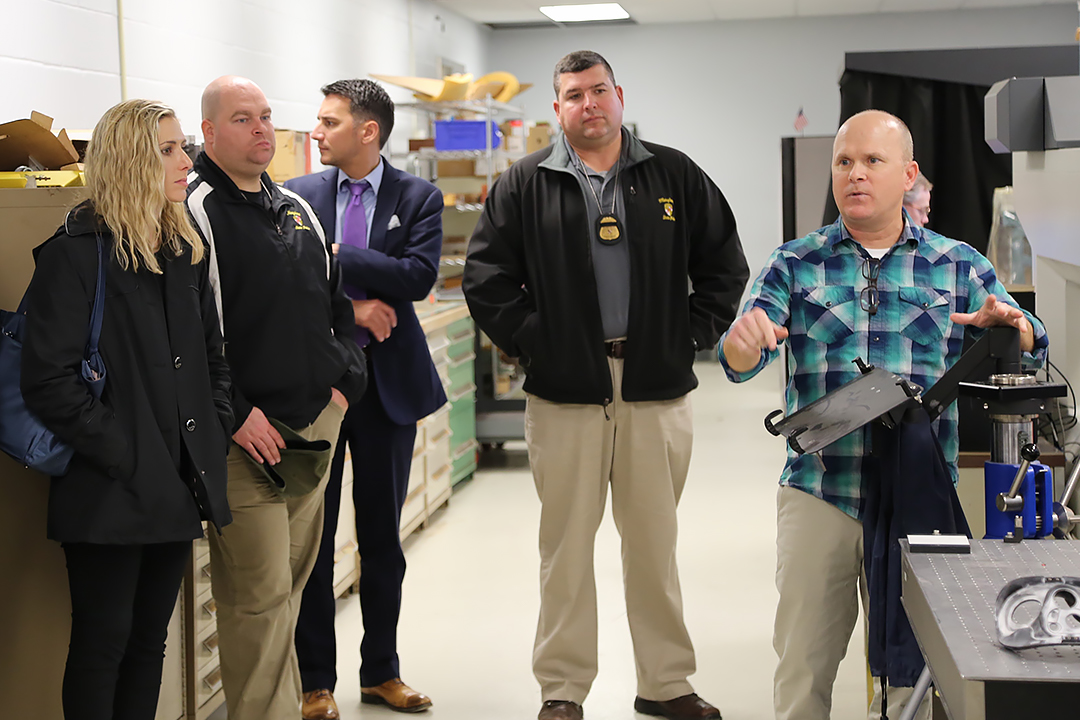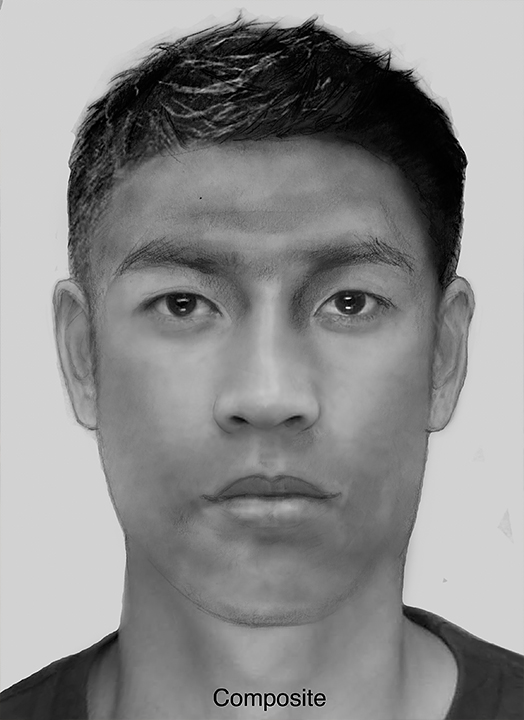// NEWS RELEASE
ECBC Assists Troopers in Efforts to ID Murder Victim
CCDC Chemical Biological Center Public Affairs | December 21st, 2017
ECBC Assists Troopers in Efforts to ID Murder Victim
DEVCOM CBC Public AffairsDecember 21st, 2017

Maryland State Police officials listen as Rick Moore, chief of ECBC's Rapid Technologies and Inspection Branch, discusses the Center's capabilities.
After playing an important role in a murder investigation, the U.S. Army Edgewood Chemical Biological Center (ECBC) could prove itself to be a valuable crime-solving partner with local law enforcement.
In September, Maryland State Police homicide investigators found skeletal remains on the side of a highway in Anne Arundel County, and they determined that the victim had been murdered. However, the body was decomposed and lacked identification, making it difficult to name the victim.
Unable to find a DNA match, homicide investigators were at a dead end. Without knowing who the victim was and whom he may have associated with, investigators couldn’t solve the murder.
After being contacted by the state police, ECBC scientists found a potential solution. By using 3D printing technology, scientists could create a replica of the skull, enabling police experts to render a facial likeness of the victim, which could lead to an identification.
“The medical examiner’s office sent us the CAT scan data which we converted into a computer file that we sent to a 3D printer,” said Rick Moore, chief of ECBC’s Rapid Technologies and Inspection Branch.
From a 3D printed model, experts can examine the bone structure to predict how facial muscles and skin would lay on the skull.
“From an autopsy, they were able to scan the actual skull, make a 3D model, and then come up with a facial likeness that we could use to identify who this skull belongs to,” said Lieutenant Scott Cook, commander of the Maryland State Police homicide unit. “That’s the first step in trying to solve this murder.”
With a rendering of the victim’s facial likeness, investigators hope for someone to come forward and identify the body.
“The skull composite was done to assist with having a forensic facial reconstruction completed. We hope that putting the facial reconstruction out to the public through the media will help us identify the victim,” Cook said. “The investigation is ongoing, but we are optimistic that once the victim is identified, we will be able to move forward quickly with identifying a suspect or suspects.”
While they haven’t yet identified the victim or solved the crime, MSP investigators were intrigued by ECBC’s capabilities and wanted to learn more about how the two organizations could partner in the future.
“Part of the purpose of this was to learn what other capabilities ECBC has that could be useful to law enforcement,” Cook said. “It’s to see if and how we could partner with ECBC, what we could do for ECBC, and what ECBC can do for us.”
During a tour of one of ECBCs’ facilities, led by Moore, Cook and his colleagues learned about ECBC’s capabilities in the fields of computer animation, augmented and virtual reality, and 3D printing.
Cook pointed to a few of ECBC’s capabilities, like augmented reality and virtual reality tools, as areas where he saw tangible possibilities for law enforcement use.
“The virtual reality training tool for high risk entries, that would be an area where I see a certain law enforcement value,” he said.
In virtual reality, users are immersed into a digital environment. Augmented reality is slightly different; instead of being immersed into a digital environment, users have their environment augmented with digital overlays.
With knowledge of the building’s design, investigators could create a replica in virtual reality for officers to undergo entry training. Augmented reality could be used to include details as the mission is underway.
Computer animation is also being used to create a digital library of firearms and potential modifications to them, another tool that could prove useful to law enforcement. Moore said the potential exists for computer animation to generate facial likeness, should operators have the knowledge and experience to do so.
Moore said he sees a wealth of opportunity in a partnership with Maryland State Police. In fact, the state police plan on inviting ECBC to a crime scene to see what ECBC can do in the field.
“They want to take us to a crime scene location and use our equipment to capture 3D imaging,” Moore explained. “From that, they can basically capture measurable 3D data that they can use to potentially reveal facts or help solve the case.”
That information could be used to determine the trajectory and origin point of a fired bullet without physically touching any part of the crime scene.
Moore noted that ECBC already has a partnership with the U.S. Bureau of Alcohol, Tobacco, and Firearms (ATF).
Doug Brunelle, branch chief of visual information services for ATF, said the partnership has been valuable. He said ATF’s partnership with ECBC led to a better way of collecting shell casings for identification and testing.
What ECBC provides, he said, is a wide range of technologies and expertise all available under one roof.
“You’re not going to find all this under one roof in the commercial market,” he said. “Here you have everything you need in one place.”
Moore said a partnership with the Maryland State Police would be mutually beneficial.
“That’s the ultimate goal, for them to prove that this works for them,” he said. “For us, it’s just a matter of using our capabilities in a different way from our usual use, which could build readiness for the U.S. Army.”
The U.S. Army Combat Capabilities Development Command (DEVCOM) leads in the discovery, development and delivery of technology-based capabilities to enable Soldiers to win our nation’s wars and come home safely. DEVCOM is a major subordinate command of the U.S. Army Futures Command. The DEVCOM Chemical Biological Center is the Army’s principal research and development center for chemical and biological defense technology, engineering and field operations. The DEVCOM Chemical Biological Center is headquartered at Aberdeen Proving Ground, Maryland.

